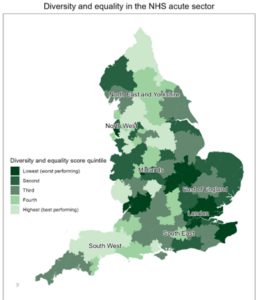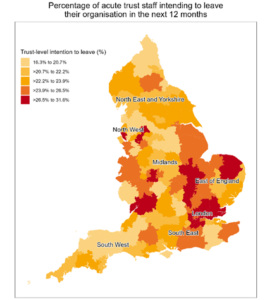Workplace discrimination and equality concerns driving NHS acute staff exodus

Almost a quarter of surveyed staff working for NHS England acute trusts stated in their 2022 Staff Survey that they intend to leave their role in the next 12 months.
Workplace discrimination and equality concerns are the most significant factors driving acute staff to leave the NHS, according to analysis of the 2022 NHS Staff Survey conducted by consultancy firm Lane Clark & Peacock (LCP).
In a workforce already plagued by burnout, stalling pay and low morale, the findings will come as concern for policymakers seeking to staunch and reverse the flow of acute staff leaving the NHS. The acute sector employs more than 850,000 full-time equivalent staff, 25 per cent of whom are Asian, black or another minority ethnicity, compared to 13 per cent of all working-age adults in the UK.
Among the diversity and equality issues highlighted in the NHS Staff Survey were: a lack of fairness in career progression and promotion (reported by one in eight respondents); discrimination from managers or other colleagues (nearly one in ten); discrimination from patients, their relatives, or members of the public (more than one in twelve); and a lack of respect for individual differences (almost one in twelve).
There was variation in staff responses based on their ethnic background. In particular, 17.2 per cent of staff from ethnic minority backgrounds reported experiencing discrimination from their manager or colleagues, compared to 6.8 per cent of white staff members. These findings are notable in light of recent reports documenting a pattern of racism and discrimination in the NHS.
LCP also looked at all the acute trusts across England to identify which areas most struggle with the diversity and equality issues named above. London and the East of England are the worst-performing regions, but the problem is widespread.

Hotspots for staff dissatisfaction
There is a stark geographical contrast across England when it comes to staff planning to leave the NHS. Trusts with the highest percentages of staff intending to leave are overwhelmingly located in London and the East of England, while trusts with the lowest percentages of staff intending to leave are concentrated in the North West and North East and Yorkshire.

Natalie Tikhonovsky, Analyst in LCP’s Health Analytics team, said: “Our analysis reveals a grim picture of low satisfaction levels and higher staff turnover rates currently facing the NHS acute sector. Understanding what is driving this will be key to the success of the government’s new workforce plan and to the overall aim of reducing steadily increasing wait lists.”
Catrin Treharne, Principal in LCP’s Health Analytics team, also commented: “The next steps for improving the NHS’s organisational health could include addressing disparities in staff satisfaction levels between trusts and investing in diversity and equality efforts to foster inclusive workplace environments. By understanding the root cause of NHS workforce challenges and designing solutions to properly address these, we can improve not only workforce satisfaction in the NHS but also patient satisfaction and outcomes.”